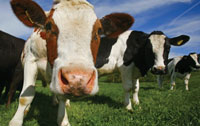‘You are what you eat,’ so the saying goes. With worries over the burgeoning global population – expected to hit 9bn by 2050 – and future food security looming ever larger on the political agenda, it is not only how much but what we eat that is becoming increasingly important, according to food researchers.
At least 1bn people around the world suffer food shortages while many more have problems sourcing food of ‘adequate nutritional value,’ said Carol Wagstaff, a plant and nutritional scientist at the UK’s University of Reading, speaking at a recent SCI meeting on biofortified and functional foods. ‘In contrast, many consumers in the developed world are facing problems linked to obesity caused by over-consumption of highly processed unhealthy food which places an economic burden on the associated health services,’ she added.
Plants have the potential to alleviate both these issues, Wagstaff believes, because lurking within their germplasm is likely to be material with high resistance to pests and diseases along with tolerance of climate stresses; enhanced nutritional density of essential minerals, vitamins and other bioactive compounds; and optimal protein and carbohydrate composition, she explained. Tapping into this genetic biodiversity should lead to novel nutritionally-enhanced varieties of plants.
Upping the nutritional value
Biofunctional and biofortified foods containing elevated amounts of these plant phytochemicals are a way of boosting levels of such compounds in the diet, continued Richard Mithen of the UK’s Institute of Food Research. While LDL cholesterol-lowering spread Benecol is arguably the best known of functional foods, another more recent example is the tomato extract Fruitflow that inhibits platelet aggregation, a known cause of heart attack, stroke and venous thrombosis, which was approved by European regulators at the end of 2009, Mithen pointed out.

Wagstaff’s group is currently developing new varieties of lettuce that lack some of the sesquiterpenoid lactones that confer a bitter taste on salad leaves, while preserving others linked to health benefi ts. In plants, she explained these compounds are involved in defence and ‘allelopathy’ or signalling, whereas in humans they have been found to alleviate certain neurodegeneration processes, sensitise patients to cancer treatment drugs, and help with the healing of burns and treatment of flu.
Other work by the group has involved looking at how plants are grown and managed pre-harvest, which also has an impact on their nutritional content. Wagstaff explained that a change in the intensity of light available to the crop, for example, depending on the extent of UV light penetration through the plastic films of the polytunnels in which they grow, has been found to make a huge difference on levels of bioactives in plants such as soft fruits, rocket and other salad leaves. With strawberry and red-leaved lettuce plants, for example, the more UV light they receive the more intense is the red pigmentation and therefore the more health-giving polyphenols they contain, Wagstaff pointed out. Current commercial polytunnel plastics already allow a fair amount of UV light penetration, but other plastics that allow more light through could potentially raise nutritional levels, she commented. A good or bad summer can have similar effects, with levels of constituent compounds sometimes varying dramatically.
Post-harvest management of plants can likewise impact on biochemical composition, although the effects are not always straightforward. While most plants are optimally chilled during transport and storage, Wagstaff explained, this has adverse effects for some, such as the herb basil, resulting in discoloration of the leaves and the loss of important flavour compounds. Wild rocket, by contrast, she added, actually generates more anthocyanins on storage because it produces more of these healthgiving compounds if the plant is stressed, when external conditions are cold and dark.
‘There is no one hard and fast rule, the trick is to optimise the post-harvest supply chain for each of your fruit and veg in order to get the optimum results,’ Wagstaff said. ‘Yield, fl avour, nutritional density and shelf-life all have room for improvement and there are some simple solutions to big challenges.’
Phytochemicals in fruits and vegetables are involved in a host of biochemical transformations, including cell signalling and infl ammatory pathways, and some are antioxidants, continued Lisa Ryan, senior lecturer in human nutrition at Oxford Brookes University, UK. Anthocynanin compounds, for example, are responsible for many of the bright red and blue colours of different fruits and vegetables, Ryan explained; over 300 anthocyanins are known and they modulate activity of the enzyme glutathione peroxidase and affect gene expression, as well as functioning as antioxidants.
Interest in using these compounds as food colorants gained popularity after a link in 2007 between hyperactivity in children and synthetic colorants, Ryan continued, while plant breeders have also recently harnessed some of these compounds to produce purple potatoes, carrots, sweet potatoes and tomatoes. Also in the pipeline, she said, is a purple milk recently approved by US regulators and which will be available to US consumers from 2014. As well as their anticancer and healthy ageing/brain and memory effects, anthocyanins also change the way the body uses insulin and stores fat, she continued, and so can help people lose weight even when they eat the same calories.
However, harnessing such phytochemicals and other plant nutrients for human nutrition is not always straightforward, pointed out Martin Broadley, professor of plant nutrition at the UK's University of Nottingham, because levels can often vary markedly with genotype and cultivation conditions, for example, fertiliser usage. Up to 10- fold differences have been seen for some elements such as magnesium, he noted, adding that dietary intake surveys show that more than 25% of adults are likely to be at risk of calcium and magnesium defi ciency globally. For potassium, zinc and iron, this fi gure increases to more than 30%, he said, while for selenium, regional differences are widespread.
Nottingham researchers are currently involved in a project, together with Rothamsted Research and the James Hutton Research Institute, to compare the effects of conventional breeding and fertilisers on the amount of calcium in brassicas. A major part of the project involves plant breeding experiments, while other field-based experiments involve growing crops, such as pak choi, Chinese cabbages, cabbages and cauliflowers, with various commercial fertilisers, Broadley explained. Based on the results of controlled experiments in the lab, he said it should be possible to increase calcium levels 50% or more by applying fertilisers, adding that the results will be useful for informing growers about what increases in calcium they can expect by applying different fertiliser formulations.
Mithen, meanwhile, pointed to a broccoli variety claimed to boost the body’s antioxidant levels at least 2-fold more than other leading broccoli varieties. Beneforté broccoli, the result of a 10-year project between Mithen and IFR/John Innes Centre colleagues, along with collaborators at UK biotech Plant Biosciences, will go on sale to US consumers later this year. A cross between a popular commercial and a wild type broccoli variety containing the desired genes, the new brassica contains higher levels of cancer-fighting glucosinolate compounds alongside the vegetable’s high iron and vitamin C levels, Mithen said.
Plant fertilisers offer yet another way of raising plant nutrient levels, according to Yara’s Kevin Moran. In fact, ‘50% of the nitrogen in our bodies comes from the Haber-Bosch process used to make fertilisers,’ Moran commented, while the sulfur content of fertilisers is also important for improving the quality of bread-making by raising protein levels in wheat, he added – a result of increasing levels of sulfur-containing amino acids. ‘Fertiliser application impacts human health in myriad ways,’ Moran commented: ‘While farmers have always applied nutrients to achieve high yields, it is often overlooked that many healthgiving components of crops are actually boosted by fertiliser applications.’
‘At the other end of the scale micronutrients, especially zinc, selenium and iodine, can be optimised in the diet by applying them to crops as part of a balanced fertiliser programme – a process known as agronomic bio-fortification.’ The trick, Moran said, lies in achieving the 4Rs of sustainable stewardship: applying the right fertiliser, at the right time, in the right amount, in the right place.
Current efforts to raise agricultural productivity – the amount of food grown per hectare of land – need to go hand in hand with a greater emphasis on food quality, Moran noted: the goal should not just be about how much we eat but what we eat and its nutritional value. ‘The conclusion is we need a new agricultural paradigm, linking agriculture to human health: what makes food healthful, what influences consumer choice and how that impacts on health.’
Research focus on pasture effects offers route towards healthier beef steaks
Health concerns over the fat content of meat and dairy products are often due more to the quality rather than the quantity of the constituent fats, according to Aberystwyth University’s Michael Lee. A standard beef steak from a Friesian cow, for example, typically comprises less than 5% fat, Lee pointed out; however, about half of this is saturated fats associated with an increased risk of heart attack and strokes.

One method to boost levels of PUFAs in meat and dairy produce involves adding fish oils to forage diets to increase amounts of long chain PUFAs, such as eicosapentenoic acid (EPA) and docosahexanoic acid (DHA). Less well-known is the use of the enzyme polyphenoloxidase (PPO) found in red clover plants, which protects PUFAs by reducing the lipolysis processes, Lee said, referring to a recent study in which levels of C18:2 long chain PUFAs were doubled in the milk of cows fed forage containing PPO. Ironically, PPO is generally seen as bad in the food industry because it leads to the browning of fruits and vegetables, he added.
Another more natural method to raise PUFA levels being investigated by the Aberystwyth researchers involves harnessing certain compounds associated with improved summer milk composition (C&I, 2011, 11, 9). Summer milk from dairy cows is known to contain higher levels of beneficial fatty acids than winter milk, as a consequence of the animals eating fresh pasture rather than conserved forage.
‘This pasture effect may be due to the different fatty acid fractions of fresh grass and conserved forage,’ Lee noted. However, it has also been attributed to the antimicrobial effects of compounds associated with the ‘green odour’ of cut grass. These fatty acid oxidation products are formed from the action of plant lipooxygenase enzymes. By identifying some of the key compounds in this ‘green odour’ – a mixture of 300 compounds – the researchers hope to recreate the effect year-round.
A fourth method for raising PUFA levels, Lee continued, involves the use of plants such as in the genus Echium, which includes herbs and shrubby plants that comprise high levels of C18:4 fats, the production of which is the major bottleneck in the conversion of α-linoleic acid to DHA. However, more work is required to protect this fatty acid from the rumen microbes, which carry out biohydrogenation.
Surprisingly, Lee concluded by saying that beef with a higher PUFA content as a result of natural forage systems actually has a longer shelf-life by two to three days, because of its higher vitamin E content – their higher fat content should otherwise be expected to make them readily oxidised.





